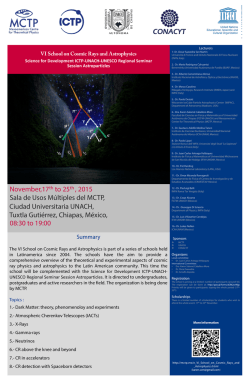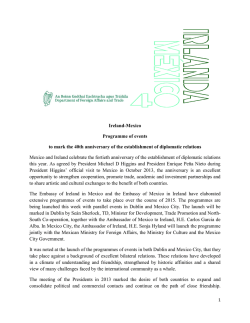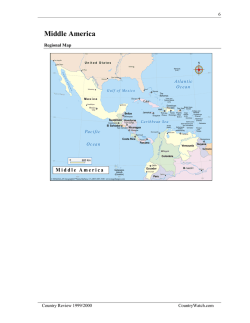
Turbinicarpus heliae (Cactaceae), a new species from Central Mexico
ISSN 2285 – 3987 Turbinicarpus heliae (Cactaceae), a new species from Central Mexico s 8.2 the passion for cacti and other succulents November 2015 Turbinicarpus heliae (Cactaceae), a new species from Central Mexico contents This is Xerophilia Special issue No 8.2 - November 2015 and it is not the official first description of Turbinicarpus heliae García-Mor., Díaz-Salim & Gonz.-Bot., sp. nov. that was already published in Xerophilia Special issue No 8.1 - October 2015. 3 · Turbinicarpus heliae 4 · Taxonomic notes 4 · Aknowledgements 4 · Literature 5 · Figures 1 García-Mor., Díaz – Salim & Gonz. – Bot., sp. nov. The graphic structure of this special issue is based on the authors' demand. Founders: Eduart Zimer • Dag Panco • Valentin Posea Editor: Eduart Zimer Nordic representative • Erik Holm Supporter • Mihai Crisbășanu Editorial team's e-Mail: [email protected]. EN edition • Eduart Zimer RO edition • Valentin Posea SP edition & Field researches • Pedro Nájera Quezada PR & Graphic • Dag Panco Cartography • Miguel Angel González Botello Graphic layout based on Andrea Cattabriga's pattern. All rights reserved – no part of this publication may be reproduced in any forms or by any means, without written permission of the Editor. All copyrighted photographs have been used under the Creative Commons Attribution 4.0 International license. Front cover Back cover Juvenile plant - detail of Fig. 1. Flowering plant - detail of Fig. 1. photo by L. J. García-Morales photo by L. J. García-Morales Contents 2 - XEROPHILIA • Special Issue No. 8.2 - November 2015 | ISSN 2285-3987 contents Turbinicarpus heliae (Cactaceae), a new species from Central Mexico. LECCINUM J. GARCÍA-MORALES1, JOSÉ F. DÍAZ-SALÍM2, MIGUEL A. GONZÁLEZ-BOTELLO3, CRISTIAN PÉREZ BADILLO4 & CLAUDIO A. FLORES LINCE5 1.Herbario, Departamento de Investigación, Museo de Historia Natural de Tamaulipas, TAMUX, Blvd. Fidel Velázquez M-1 L-1 S/N, Col. Horacio Terán, C.P 87130, Ciudad Victoria, Tamaulipas, Mexico; e-mail: [email protected] 2.Calle Retorno de Lomas Celeste 602, Lomas Residencial Pachuca, C.P. 42094, Pachuca, Hidalgo, Mexico 3.Privada de Guacamayas 3046, El Quetzal, C.P. 67169, Guadalupe, Nuevo Leon, Mexico 4.Calle Azucenas 102, Col. Colinas del Sur, C.P. 76900, Querétaro, Qro., Mexico 5.Monte Sinaí 117, Fracc. Lomas de Vista Hermosa, C.P. 42026, Pachuca, Hidalgo, Mexico contents Introduction The genus Turbinicarpus (Backeberg) Buxbaum & Backeberg (1937: 27) is a small group of 20-30 species and several infraspecific taxa of small cacti endemic to the Chihuahuan Desert and adjoining areas of Central Mexico deserts (Bravo & SánchezMejorada 1991, Donati & Zanovello 2005, Hunt 2006). On a study developed by Doweld (1998), he upgraded the taxonomic status of Turbinicarpus pseudomacrochele (Backeberg) Buxbaum & Backeberg (1937: 27) and two additional varieties of this species, creating the genus Kadenicarpus Doweld (1998: 22), on the basis of the globose to cylindric body, 5–8 straight to slightly curved spines, dry fruit at maturity, ovoid to pyriform seeds with a papillose testa but without a cuticle ornament, and a big and succulent embryo without perisperm. Donati (2003) downgraded the status of Kadenicarpus to subgenus level under Turbinicarpus remarking the infertility of the back–crosses between both subgenera due to vicariance, recognizing two sections with three species and two subspecies. This narrow group of poorly known taxa as proposed by Bravo & Sánchez-Mejorada (1991), Glass (1997), Doweld (1998), Lüthy (2002), Guzmán et al. (2003), Donati & Zanovello (2005), and Hunt (2006), comprises 1 to 3 species and several uncertain infraspecific status taxa. Recent phylogenetic studies done on several genera of Cactaceae (Hernández-Hernández et al. 2011) suggest that the genus Turbinicarpus is polyphyletic, and position Kadenicarpus as a proper independent genus. In the basis of the confusing taxonomy and nomenclature on this group of cacti, we prefer here the use of the genus name Turbinicarpus, and the use of the species level to any new names added, until a new taxonomic revision, proper nomenclatural changes and a complete phylogenetic study is conducted with all known related taxa. In recent explorations in the State of Hidalgo, Central Mexico, we found few small populations of an interesting plant related to Turbinicarpus pseudomacrochele subsp. minimus (G. Frank) Lüthy & A. Hofer (2002: 20); that exhibits unique morphological characters that separate it from the later and the rest of the known relative taxa; here we propose it as a new species to science. T. heliae García-Mor., Díaz-Salim & Gonz.-Bot., sp. nov. Turbinicarpus heliae García-Mor., Díaz-Salim & Gonz.-Bot., sp. nov. (Fig. 1, pag. 5). Planta affinis T. pseudomacrochele subsp. minimus (G. Frank) Luthy et A. Hofer, caule simplici, spinis iuvenilibus maturisque numerosioribus longioribusque, caule globoso usque ad brevicylindrico atque radice napiformi longiore, maioribus tuberculis, altioribus latioribusque, maioribus latioribusque (in diametrum) floribus albis fructibusque ovatis circiter 5 mm longis, seminibus pyriformis nigris, circiter 1 mm longis. Type: MEXICO. Hidalgo State: Actopan, 2200 m elev., 13 February 2014, L. García-Morales 3398 (Holotype ITCV, Isotype GBH). Young stems simple, elongated, 40–60 mm × 5–9 mm, claviform, with 16–20 white pectinate short radial spines to 1 mm long, appressed, areoles ovoid, 0.8–1 × 0.2–0.3 mm. Mature plant stems simple, 30–60 × 12–20 mm, clearly separated by a neck from the roots. Tubercles conical-pyramidal, 2–3 mm long and wide at base, dark green with glaucous tinged areas, arranged in 9–10 spiral series. Main root tuberose or tap root, 40–70 mm long and 15–20 mm wide, with secondary shot-roots appearing irregularly. Spines 10–18, radiating, 2–3 mm long, straight or slightly curved, white; 3 or 4 upper spines longer and tortuous, forming a bunch, white to grayish with darker tips. Areoles oval, 1–1.5 mm long and 1 mm in diameter, with white felt on the upper area when younger. Flowers funnel form, 15–22 mm long and 20–24 mm wide; external perianth segments 7–9, lanceolate, 10–12 mm long and 1–2 mm wide, white with a pink to magenta midstripe; internal perianth segments 10–12, lanceolate, 10–15 mm long and 2–3 mm wide, with the apex acuminate, white or with a fine pink to magenta midstripe. Ovary ovoid, reddish, 3–4 mm long and 2–3 mm diameter, ovary walls 1 mm thick. Style white, 10 mm long, stigma lobes 5 to 6, white, crenated, 1–1.5 mm long. Stamens 60–80, hyalinewhite, 8–12 mm long, anthers yellow, 1 mm long. Fruit ovoid, 4–5 mm long and 3–4 mm in diameter, dry green with tinged purple. Seeds pyriform, 1 × 0.8 mm, black, constricted at the micropylar region, testa cells globose. 3 - XEROPHILIA • Special Issue No. 8.2 - November 2015 | ISSN 2285-3987 contents Etymology: This new species is dedicated to the life and legacy of Dr. Helia Bravo-Hollis, for her great contribution to the knowledge of the Cactaceae of Mexico Distribution and conservation: Few close populations of this species are known to date, comprising less than 500 plants accounted. The habitat of this new plant corresponds to a xerophilous scrub (Rzedowski 2005), associated with some species of cacti, agaves and shrub legumes. The soil in the area is dark limestone, with plenty of rock fractions, where the plants live among. The distribution range of this plant is about 6 km2; the plants inhabit the upper slopes of small hills between 2200 and 2300 m elevation. The main threat to Turbinicarpus heliae is cattle grazing as the habitat is not suitable for agricultural activities. We propose the conservation status of this species as Endangered, in sight of its narrow distribution and low number plants known throughout its distribution range. Phenology: Turbinicarpus heliae is an early flowering taxon, beginning in late January and extending irregularly into early April, the fructification occurs 6–8 weeks after pollination. No pollinators were observed in field, but damaged flowers by ants were present. Taxonomic notes: This species is related morphologically and geographically to Turbinicarpus pseudomacrochele subsp. minimus, from which it is clearly differentiated because of its longer (30–90 mm) single stems (vs. clumping, 20–60 mm), more numerous spines account in young (16–20) and mature plants (10–18), and the bigger (22 × 24 mm) white flowers with a thin middle pink or magenta stripe vs. yellow-green (15 × 18 mm). Discussion Turbinicarpus heliae extends the known distribution range of the genus Turbinicarpus sensu lato, being the southernmost known species of the genus to now, particularly related to T. pseudomacrochele subsp. minimus, but with slender and longer stems, numerous spine account and white flowers, characters not present in the close related allies. The discovery of additional populations of this endangered species is necessary to improve the knowledge on the biology and distribution of this new interesting plant. The taxonomic position of this interesting new plant is unclear to now, as recent authors have proposed changes on the specific and subspecific status of the close related taxa; we encourage more morphological and phylogenetic studies to understand the relationships between them all. Nomenclatural changes are needed to update the new findings through molecular data that support the elevation of the generic status of this small group of taxa. Acknowledgements To the Museo de Historia Natural de Tamaulipas, TAMUX. To the Instituto Tamaulipeco para la Cultura y las Artes, ITCA, for their support on this work. We are indebted with George Hinton and Evelyn Rios for their comments and reviewing of the manuscript. We aknowledge specially Dr. Ioana Munteanu from the University of Bucharest, Faculty of Foreign Languages, Department of Classics, for her valuable help in the revision of the latin grammar. contents Literature •Bravo-Hollis, H. & Sánchez-Mejorada, H. (1991b) Las Cactáceas de Mexico Vol. II. UNAM, Mexico City, 404 pp. •Buxbaum, F. & Backeberg, C. (1937) Jahrbuch der Deutschen Kakteen-Gesellschaft (1): 27. •Donati, D. (2003) Revisione Tassonomica del Genere Turbinicarpus Backeb. & Buxb. Bologna, Italia, 35 pp. •Donati, D. & Zanovello, C. (2005) Knowing, understanding, growing Turbinicarpus-Rapicactus. Cactus Trentino Südtirol, Trento, Italia. 254 pp. •Doweld, A.B. (1998) A phylogenetic outline of the system of classification of the Tribe Cacteae (Cactaceae, Cactoideae) 1. System of classification of the subtribes Sclerocactinae – Bгavocactinae – Turbinicaгpinae. Sukkulenty 1(1): 15-30. •Glass, C. (1997) Guía para la identificación de cactáceas amenazadas de Mexico. CONABIO – CANTE, México. 106 pp. •Guzmán, U. Arias, S. & Dávila, P. (2003) Catálogo de Cactáceas Mexicanas. UNAM – CONABIO, Mexico City, 316 pp. •Hernández-Hernández, T., Hernández, H.M., De-Nova, J.A., Puente, R., Eguiarte, L.E. & Magallón, S. (2011) Phylogenetic relationships on Cactaceae (Caryophyllales, Eudicotyledoneae). American Journal of Botany 98 (1): 44-61. •Hunt, D. (2006) The New Cactus Lexicon, Vol. I, Text. DH Books, England, 374 pp. •Luthy, J.M. (2002) Further comments on Turbinicarpus and key to species. Cactaceae Ssistematics Initiatives 14: 20-25. •Rzedowski, J. (2005) Vegetación de Mexico, 1era. edición digital. CONABIO, Mexico City, 505 pp. T. heliae García-Mor., Díaz-Salim & Gonz.-Bot., sp. nov. 4 - XEROPHILIA • Special Issue No. 8.2 - November 2015 | ISSN 2285-3987 contents contents FIGURES 1- Turbinicarpus heliae. A. Holotype prior to preservation, L. García-Morales 3398 (bar = 10 cm). B. Detail of a flowering adult plant. C. Juvenile seedling showing the spine arrangement. T. heliae García-Mor., Díaz-Salim & Gonz.-Bot., sp. nov. D. Longitudinal section of a flower (bar = 20 mm). E. Seed side shape and structures (bar = 1 mm). F. Seed shape at micropylar region (bar = 0.5 mm). Photographs: L. J. García-Morales. 5 - XEROPHILIA • Special Issue No. 8.2 - November 2015 | ISSN 2285-3987 Photo by Cristian Pérez-Badillo. contents contents FIGURES 2 - Turbinicarpus heliae García-Mor., Díaz-Salim & Gonz.-Bot., sp. nov., adult and juvenile plants in habitat. en ro or T. heliae García-Mor., Díaz-Salim & Gonz.-Bot., sp. nov. 6 - XEROPHILIA • Special Issue No. 8.2 - November 2015 | ISSN 2285-3987 Photo by Cristian Pérez-Badillo. contents Photo by Leccinum J. García-Morales. 1 2 3 4 en ro or T. heliae García-Mor., Díaz-Salim & Gonz.-Bot., sp. nov. 7 - XEROPHILIA • Special Issue No. 8.2 - November 2015 | ISSN 2285-3987 Photo by Cristian Pérez-Badillo. Photo by Cristian Pérez-Badillo. contents Photo by Cristian Pérez-Badillo. FIGURES 3 Turbinicarpus heliae García-Mor., Díaz-Salim & Gonz.-Bot., sp. nov., adult plants in habitat. Details: 1 & 2 - Flowering plants in habitat. 3 & 4 - The habitat of the species. Xerophilia – Special Issue, No. 8.2 - November 2015 www.xerophilia.ro ISSN 2285-3987
© Copyright 2025





